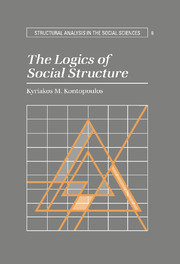Book contents
- Frontmatter
- Contents
- Preface
- Introduction
- Part I Metatheoretical considerations
- 1 Epistemic strategies in contemporary science
- 2 The dynamics of emergence: the case against reductionism
- 3 The nature of hierarchical and heterarchical organization
- 4 Some formal theses on hierarchy and heterarchy
- Part II Compositionist logics
- Part III Logics of hierarchy
- Part IV Heteracrchical logics
- Part V The phenomenology of social structures
- Appendix: The logics of structuration
- Glossary
- Bibliography
- Index
2 - The dynamics of emergence: the case against reductionism
Published online by Cambridge University Press: 24 October 2009
- Frontmatter
- Contents
- Preface
- Introduction
- Part I Metatheoretical considerations
- 1 Epistemic strategies in contemporary science
- 2 The dynamics of emergence: the case against reductionism
- 3 The nature of hierarchical and heterarchical organization
- 4 Some formal theses on hierarchy and heterarchy
- Part II Compositionist logics
- Part III Logics of hierarchy
- Part IV Heteracrchical logics
- Part V The phenomenology of social structures
- Appendix: The logics of structuration
- Glossary
- Bibliography
- Index
Summary
Several preliminary arguments were offered in the previous chapter countering the moves of reductive materialists and indicating possible meanings of the concept of emergence. In this chapter we will focus on the positive characteristics of emergence, and answer three basic questions:
what exactly is emergent and how is it brought about;
how could step-wise emergence be possible; and
what are the results of emergence, which presumably appear as entities in the hierarchy of phenomenological levels.
Some preliminaries: emergence as irreducibility
As argued earlier, the size or quantity-, time-, context-, loop-, and selection-dependence of higher-level phenomena frustrate the purposes and efforts of microreduction. These forms of dependence demonstrate persuasively that contrary to the main reductionist argument, because of their history, evolutionary, emerging higher-level phenomena are in principle irreducible to lower-level phenomena. Instead, they show, at the very least, that microreduction cannot be done trivially – that even though diachronic reduction may be theoretically possible, synchronic reduction is in practice impossible (Simon's [1965] minimalist thesis on emergence).
The minimalist position is, perhaps, able to rebut extreme forms of reductive materialism, that is, a belief in the causally determinative power of microparts to bring forth by themselves alone, intrinsically and fully, higher-level forms of organization in our universe. Yet, minimalism may not be sufficient to counter more moderate reductionist programs such as that of eliminative materialism, which are actually based on a conflation of the reductive and constructionist strategies
- Type
- Chapter
- Information
- The Logics of Social Structure , pp. 25 - 41Publisher: Cambridge University PressPrint publication year: 1993



